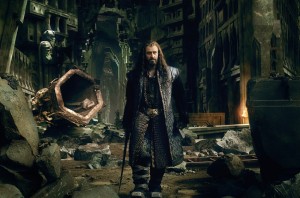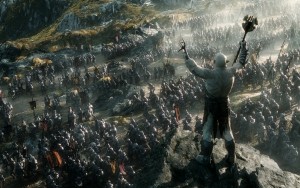
It’s been a long road, but The Hobbit: The Battle of the Five Armies finally marks the end of any more foreseeable Tolkien filmic adaptations. While The Lord of the Rings trilogy enraptured audiences, The Hobbit series hasn’t quite grabbed the public in the same manner. It may be a matter of unrealistic expectations or source material more suited to children than adults, but it’s been something of a mixed bag thus far (at least for this reviewer, with The Desolation of Smaug standing out as the most memorable).
This final installment throws everything but the kitchen sink at us, including a face off with a dragon, an epic battle and teary-eyed goodbyes as well as sequences designed to set up the The Lord of the Rings movies. It tries very hard, has some good moments and is certainly enjoyable to a degree, but it also feels as if fatigue has truly set in. The movie is receiving a recommendation, though more for perseverance and accomplishment of a Herculean undertaking than for being a dramatic success.
 The story begins with the dragon Smaug rampaging through Lake Town, but this thread is dealt with relatively quickly. Instead, the bulk of the film deals with Dwarf leader, Thorin (Richard Armitage). Now surrounded by incredible spoils inside the dragon’s home (known as Lonely Mountain), Thorin becomes greedy and paranoid. He sets off a chain of events that threaten war between his group, the Elves and Mankind. While the bickering intensifies, the evil Sauron makes his presence known and enacts a plot for world domination by sending nasty Goblins to wipe them all out.
The story begins with the dragon Smaug rampaging through Lake Town, but this thread is dealt with relatively quickly. Instead, the bulk of the film deals with Dwarf leader, Thorin (Richard Armitage). Now surrounded by incredible spoils inside the dragon’s home (known as Lonely Mountain), Thorin becomes greedy and paranoid. He sets off a chain of events that threaten war between his group, the Elves and Mankind. While the bickering intensifies, the evil Sauron makes his presence known and enacts a plot for world domination by sending nasty Goblins to wipe them all out.
While the action-packed dragon opening works very effectively and the themes of greed and power are an interesting addition to the storyline, one role suffers greatly from the shift in focus. Bilbo Baggins (Martin Freeman) has little to do for the entirety of the film and the screenplay strains desperately to involve him in the proceedings. The likable title character is pushed into the background (and even knocked unconscious for a good portion of the film). No one expects Bilbo to be a swashbuckling hero, but at least the other films found a way to make its Hobbits an important part of the proceedings.
And there’s a bit too much of everything in the battle royal, with what feels like almost a third to one-half of the running time devoted to the large fracas. I’m not one to complain about epic confrontations and dramatic conflict, but that’s an awful lot of shouting and clanking swords, even for me. Thankfully, the choreography is exceptional and there are wildly imaginative send-offs in the snow-capped mountains – Goblins are sliced and diced in a creative and varied ways. Yet it is all too padded out. In fact, it becomes repetitious to the point of exhaustion.
 The final twenty-something minutes become a series of slow-motion shots of secondary characters reacting to the death of a friend, only to find themselves in the identical predicament minutes later (and have another individual watch them with the same aghast expression). By the third or fourth occurrence, the pattern starts to become more amusing than emotive. It also doesn’t help that with so many roles, many aren’t as memorable. In the end, the great and elaborate lengths gone to give all of them a big send off don’t resonate as deeply.
The final twenty-something minutes become a series of slow-motion shots of secondary characters reacting to the death of a friend, only to find themselves in the identical predicament minutes later (and have another individual watch them with the same aghast expression). By the third or fourth occurrence, the pattern starts to become more amusing than emotive. It also doesn’t help that with so many roles, many aren’t as memorable. In the end, the great and elaborate lengths gone to give all of them a big send off don’t resonate as deeply.
This all sounds a bit harsh. If you’ve enjoyed the other chapters in the series, you’re going to see it and will likely appreciate this effort well enough. It’s just unlikely to have as much of an impact as the previous films. The Hobbit: The Battle of the Five Armies is still a decent, well-produced and impressive fantasy film. One must compliment the cast and crew for their incredible effort. Whether it is the tiredness of the audience or the strains of such a production on the filmmakers, it just so happens that the fractures in Middle Earth are a little more substantial this time out.


